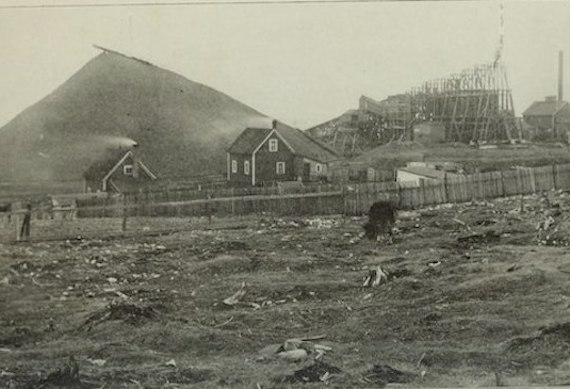Ghosts, Fairies, and a Spectral Hag on Canada’s Most Haunted Island

Located in Conception Bay, a large bay in the southeast of the island of Newfoundland, Canada, Bell Island is a thirty-four-square-kilometre windswept rock surrounded by sweeping cliffs and home to four settlements with a total of over 2000 inhabitants. It seems like mostly a quiet, picturesque place and at first glance it would be hard to imagine that the island has a long history of tragedy and numerous legends of fairies and hauntings, to the point that it is often called “the most haunted island in North America.”
Although Natives long used the island as a fishing ground, the first permanent settlement came when white settlers began a fishery there. When it was found that the island was also rich in iron ore, The Old Dominion Iron and Nail Company opened in 1832, which brought with it an influx of settlers that spurred the growth of the budding, prosperous town of Wabana. By 1895, there was an expansive iron mining operation in effect, and Bell Island quickly grew into one of the most important iron ore producers in the world. It was down there in the dim, dank mining tunnels that the island’s tragic history would begin. At the time, safety precautions were a mere after thought. When the mines first opened miners, mostly men but sometimes boys as young as 10, worked down in the claustrophobic darkness wearing little more than felt baseball hats with a flickering candle on top to push away the clinging blackness and perhaps a tin lamp burning seal oil perched on a rocky ledge. Down here the men labored away in horrific conditions, handling explosives and risking their lives every day, and there were many injuries and deaths from explosions, mishaps, or lung disease brought on by the dust and fumes of the mines. Henry Crane, Bell Island’s tourism chairman, has said of the working conditions at the time:
When the mines opened in 1895, and the last mines closed in 1966, there were 106 fatalities and triple accidents. Miners (all men) lost legs, arms. Some were left disfigured and rendered useless. Others died of lung disease. The miners had no proper bathroom or eating facility, there was no warmth, and they worked 10 to 12-hour shifts for six days a week, for five to seven cents an hour, seeing the sunlight — while bleary-eyed — only on Sundays. The site contained four major underground mines called No. Two, Three, Four, and Six, and they ran about three to five miles in length. Then, on the surface, there were two mines called No. One and Five that were ‘mined out’ before going underground.

Yet despite this, mining permeated every aspect of the islanders’ lives, it was their livelihood, all they knew, and so they plugged along. During World War II, Bell Island was very important to the Allied war industry, which led to Nazi Germany attacking twice, and at its peak, more than 12,000 people lived there. When mining stopped in 1966, the island’s economy took a turn for the worst and many people left, yet the island’s turbulent history remained, as did its various ghosts and spirits.
By most accounts, Bell Island is absolutely crawling with spooks. The most obvious offenders are the spirits of various dead miners said to lurk about in and around the old mines. There are numerous tales of people seeing phantom miners down there in the darkness, as well as suddenly finding white crosses etched into the stone where there were none moments before. The white crosses were used by miners as a way of honoring their fallen, making it seem as if they are trying to communicate to the living from beyond the grave. Besides the shadow figures and mysteriously appearing crosses, visitors have heard muffled disembodied whispering or footsteps, felt an icy wind rush past, and often there is a dreadful feeling of being watched.
Although the ghosts of miners are a prevalent tale, perhaps the most famous haunting on the island revolves around a patch of marshy farmland known as Dobbin’s Garden. The story begins back in the Second World War, when German U-boats attacked the island. According to the tale, German soldiers snuck onto the island in order to resupply their U-boat with the help of local sympathizers. As they went about their clandestine business, a young local woman is said to have stumbled upon them, after which she was dragged off and killed in the swamp. Ever since then, her spirit is said to appear, first as a beautiful young woman, but as she approaches she falls to her knees and begins crawling as her white clothes transform into tattered grey rags, her flesh falls from her skin, and her visage twists and contorts into a toothless, horrible old hag. She is also supposedly accompanied by a wretched, nauseating stench, which Crane assures us is “like rotten eggs, but ten times worse. So you can’t breathe,” and she is said to groan “No one came to help me, now no one will help you. Taste what I tasted. Smell what I smelled.” The legend is so popular that in 2016, “The Bell Island Hag” was immortalized in a Canada Post Halloween-themed stamp, and she is still the focal point of many haunted tours of the island to this day.

Another specter said to haunt the island is a phantom of a woman in a white dress, whose story goes back to the 1940s with a “serving girl” working as a maid in one of the well-to-do homes in Wabana. The story goes that one day the woman went missing, and a search could find no trace of her. It was not until miners at Mine No 4. Were out collecting water from a well that she would be found, her bloated body stuffed within the well and obviously murdered. After that, her vengeful spirit was seen roaming about attacking men. Crane explains of the story:
There was no running water so that the men would collect buckets from a well. One day, the men went to collect water and, to their horror, discovered the body of a young woman, dressed all in white, floating in the well. Murdered. Her skin had turned an icy blue. Men that were heading home after a long and arduous day got fiercely attacked by this ghost of this woman. Wounded, they got treated at the nearby hospital. These events happened until the mid-1960s, after the discovery of the killer. The man’s family live on Bell Island, including those of the young woman, so we never reveal their names. But those that live on the Island and have studied the history will know.
Besides ghosts, Bell Island also has a long tradition of evil fairies or gnomes. There is a place on the island called Butler’s Marsh, a boggy swamp full of twisted trees that looks spooky enough even without all of the scary stories attached to it. Here there have long been said to lurk a race of malevolent fairies, described as being two feet tall and hideously deformed and of which Newfoundland playwright Robert Chafe once said “They’re mean … twisted, sinister creatures.” These fairies have long been said to get up to all sorts of mischief, making travelers lose their way, attacking the unwary, stealing things, and even kidnapping young children, and early settlers blamed them for all manner of mysterious disappearances, deaths and ailments. It is said that the only way to keep them away is to keep a piece of bread or a torn Bible page in one’s pocket at all times when venturing into their domain, or better yet to avoid their territory altogether. Crane attributes these stories to the lore that the various immigrants to the island brought with them, saying:
In the early 20th century up to 1950s, the Island had a blend of ethnicities, from English, Irish, Scottish, German, Estonian… Bringing superstitions, legends, and a cocktail of traditions. Bell Island was filled with sailors, stowaways, misfits, and the folklore mixed with the macabre. Wherever you found a piece of land, you planted your home, and a lot of things happened that people still can’t explain.
What is going on with this place? Why should it be so intensely haunted? Is it the tragedy and history of pain and suffering that pervades it? Or is this all just tall tales, spooky lore, and urban legends? Whatever one may think of it all, Bell Island is certainly a place with its fair share of history and mystique, and the stories and legends remain persistent to this day.




